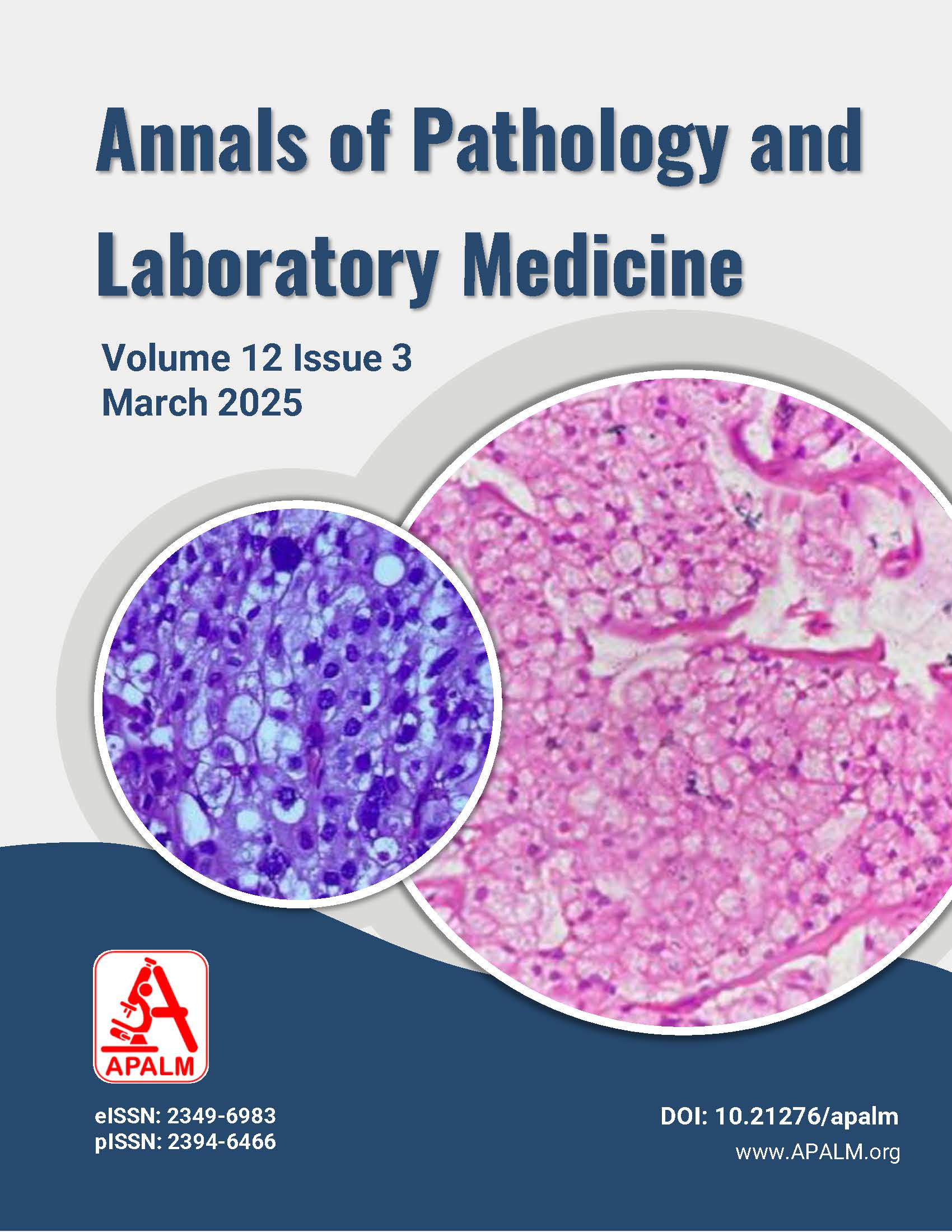Immunohistochemical Expression of Ki67 and HER2/neu in Urothelial Tumors
DOI:
https://doi.org/10.21276/apalm.3431Keywords:
Urothelial tumors, LGUC, HGUC, squamous cell carcinoma, PUNLMP, Ki67, HER2/neuAbstract
Background: Urinary bladder cancer is the most common malignancy involving the urinary system and the ninth most common malignancy worldwide. Proliferation marker kinase inhibitor (Ki67) is a nuclear and nucleolar non-histone DNA-binding protein that is encoded by the MKi67 gene in humans. Human epidermal growth factor receptor 2 (HER2) is a transmembrane tyrosine kinase receptor that is involved in cellular growth, survival, and migration.
Materials and Methods: The cross-sectional study was conducted for the duration of one year in the Department of Pathology, BPS Medical College for Women, Khanpur Kalan, Sonepat. Tissue sections, after proper processing, were stained with haematoxylin and eosin. A total of 50 histopathologically proven cases of urothelial tumors were included in the study. Correlation of urothelial tumors was studied with age, gender, smoking, and tumor grading. Urothelial tumors were classified according to the WHO classification of tumors of the urinary bladder (2016), and IHC markers Ki67 and HER2/neu expressions were evaluated.
Results: Among 50 cases of urothelial tumors, 25 (50%) cases were low-grade urothelial carcinoma, followed by 22 (44%) cases of high-grade urothelial carcinoma. Two cases of squamous cell carcinoma and one case of papillary urothelial neoplasm of low malignant potential were also observed. Ki67 expression was significantly associated with urothelial carcinoma (p-value = 0.01). HER2/neu expression showed a significant association with muscle-invasive tumors (p-value = 0.02).
Conclusion: Positive Ki67 and HER2/neu expression correlated with tumor grade. Assessing HER2/neu status could identify patients with high-grade disease who might benefit from adjuvant HER2/neu treatment after radical cystectomy.
References
1. Biswas RR, Manga S, Guha D, Basu K, Karamakar D. An epidemiological study of cases of urothelial carcinoma of urinary bladder in a tertiary care center. J Krishna Inst Med Sci Univ. 2013;2(1):82-8.
2. Madhu K, Ponwang K, Suresh B, Atin S, Janak S, Sankhwar S, et al. Immunohistochemical expression of markers KI67 and HER. Int J Curr Res. 2016;8(12):43704-8.
3. Netto GJ, Amin MB. The lower urinary tract and male genital system. In: Kumar V, Abbas AK, Aster JC, Turner JR, Perkins JA, Robbins SL, et al., editors. Robbins and Cotran pathologic basis of disease. 10th ed. India: Reed Elsevier; 2021. p. 958-61.
4. Humphrey PA. The 2016 WHO classification of tumors of the urinary system and male genital organs—Part B: Prostate and bladder tumors. Eur Urol. 2016;70(1):106-19.
5. Hall MC, Chang SS, Dalbagni G, Pruthi RS, Seigne JD, Skinner EC, et al. Guideline for the management of nonmuscle invasive bladder cancer (stages Ta, T1, and Tis). J Urol. 2007;178(6):2314-30.
6. Babjuk M, Oosterlinck W, Sylvester R, Kaasinen E, Böhle A, Palou-Redorta J. EAU guidelines on non-muscle-invasive urothelial carcinoma of the bladder. Eur Urol. 2008;54(2):303-14.
7. Raspollini LM, Taddei GL. Tumor markers in ovarian carcinoma. Int J Gynaecol Obstet. 2007;97(3):175-81.
8. Ibrahim BB, Mahmoud SA, Mohamed AA, Hanbuli HM. Expression of Her2/neu and Ki-67 in urothelial carcinoma and their relation to clinicopathological data: An Egyptian study. J Clin Diagn Res. 2021;15(3):6-9.
9. Iqbal BM, Buch A. Hormone receptor (ER, PR, Her2/neu) status and proliferation index marker (Ki67) in breast cancers: Their onco-pathological correlation, shortcomings and future trends. Med J DY Patil Univ. 2016;9(6):674-9.
10. Rahman P, Khan KH, Afroz S, Rahman MM, Rashid JS. Association of Ki-67 expression in radical cystectomy specimens of infiltrating urothelial carcinoma with histopathological parameters. Bangabandhu Sheikh Mujib Med Univ J. 2022;15(3):186-91.
11. Abid A, Sen S, Bandyopadhyay R. Clinicopathological study of urothelial neoplasms in urinary bladder with special reference to expression of Her2/neu and Ki67 in malignant lesion. Indian J Pathol Oncol. 2021;8(3):369-76.
12. Aslam M, Khadim MT, Hamdani SN, Ahsan F, Ali SS. Frequency of immunohistochemical expression of Ki67 in urothelial carcinoma bladder. Pak J Pathol. 2021;32(1):5-10.
13. Haque S, Dewan RK, Saleh S, Jennah SA, Jahan F, Akter F, et al. Histomorphological study of urinary bladder tumor and status of Her2/neu and Ki67 expression in urothelial carcinoma. J Histopathol Cytopathol. 2018;2(2):99-108.
14. Jawad NA, Ali AA, Kamal MS. Her2/neu and Ki67 immunohistochemical expression in transitional cell carcinoma of the urinary bladder. J Med Dent Sci. 2016;15(2):6-12.
Downloads
Published
Issue
Section
License
Copyright (c) 2025 Niketa Tyagi, Deepti Agarwal, Swaran Kaur, Atul Khandelwal

This work is licensed under a Creative Commons Attribution 4.0 International License.
Authors who publish with this journal agree to the following terms:
- Authors retain copyright and grant the journal right of first publication with the work simultaneously licensed under a Creative Commons Attribution License that allows others to share the work with an acknowledgement of the work's authorship and initial publication in this journal.
- Authors are able to enter into separate, additional contractual arrangements for the non-exclusive distribution of the journal's published version of the work (e.g., post it to an institutional repository or publish it in a book), with an acknowledgement of its initial publication in this journal.
- Authors are permitted and encouraged to post their work online (e.g., in institutional repositories or on their website) prior to and during the submission process, as it can lead to productive exchanges, as well as earlier and greater citation of published work (See The Effect of Open Access at http://opcit.eprints.org/oacitation-biblio.html).










